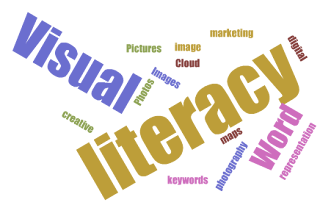Build Upon your Creative Literacy by Enhancing your Visual Literacy
By John C. Buckingham
Here is a question that might make you scratch your head: what is creative literacy? Perhaps you have never even seen these two terms together or pondered what could be “creative” about literacy? But the question is a note worthy one as it relates to academia in particular!
Let’s put the question in different terms. What is one form of literacy that empowers or channels your creative side? And in the context of this space here, how can you leverage that literacy to enhance the learning environment for your students?
I’m going to suggest one form of literacy that is absolutely critical to engagement and learning: visual literacy. In short, visual literacy refers to the ability to find, interpret, evaluate, use and produce images. As a current graduate student at California State University Long Beach, one of the biggest challenges I’ve observed that we all struggle with is the ability to produce and present rich visual images conducive to the course material.
Given that we live in a digital world with the advent of the Internet, learners are interacting with images on a completely different scale.* We students expect images as a learning tool because it’s becoming one of the most important ways that we communicate with each other. One look at networking sites like Facebook or Reddit will immediately illustrate that fact.
So, how can you enhance your creative literacy through the channel of visual literacy? A digital tool like Adobe Photoshop will empower you to create and utilize images in a way that promotes meaningful and effective interactions. It’s true that this tool has a learning curve, but the outcomes will be well worth the effort. Making your own images also has the advantage of avoiding copyright challenges.
If, however, you are short on time, try photographing some images in relation to your subject materials for a lively discussion. Using more simplified tools like Microsoft Paint, Snagit or even xMind can give your images the edge that simple, boring text cannot. As students, we want to see your creative side show itself through visual aids.
If you use Adobe Connect for online classes, there are a number of creative, “out-of-the-box” pods that can engage students on a visual level. One pod you can visually stimulate them with is the Word Cloud Pod. This pod provides a pictorial representation of words that would otherwise be perceived as dull data. The visual dimensions of this activity are the different fonts, sizes, layouts and color schemes that convey the prominence level of keywords pertinent to the subject material.
Hopefully some of these suggestions can invoke some useful cognition for channeling your creative energies and inspire you to augment your visual literacy. And as always, if you’d like an additional outlet with which to express your creative ideas, feel free consult with us at the Technology & Learning group!
Best,
John C. Buckingham
* Hattwig, Denise, Kaila Bussert, Ann Medaille, and Joanna Burgess. “Visual Literacy Standards in Higher Education: New Opportunities for Libraries and Student Learning.” Portal: Libraries and the Academy 14, no. 1 (2013): 61-89.

